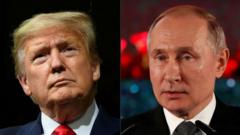In a stark warning to India, U.S. Treasury Secretary Scott Bessent indicated that further secondary tariffs could be instated depending on the outcome of the pivotal talks between President Donald Trump and Russian President Vladimir Putin scheduled for Friday in Anchorage. With the backdrop of ongoing U.S. efforts to mediate a ceasefire in the conflict between Russia and Ukraine, Bessent highlighted potential consequences if the discussions do not yield positive results.
During an interview with Bloomberg TV, Bessent mentioned, "We've put secondary tariffs on Indians for buying Russian oil. And I could see, If things don't go well, then sanctions or secondary tariffs could go up." Trump's administration recently imposed a steep 25% tariff on India for its imports of oil and weaponry from Russia, a significant move that has already exacerbated tensions between Washington and New Delhi.
As India increases its imports of Russian crude—a noteworthy rise from under 3% in 2021 to 35%-40% in 2024—U.S.-India trade relations face considerable strain. While U.S. officials have called for a united front against Russian aggression, India robustly defends its oil purchases, arguing the necessity to protect vulnerable populations from surging energy costs.
Bessent also described India’s stance in trade negotiations as "a bit recalcitrant," noting the challenges ahead as discussions aimed at easing ongoing trade tensions between the nations recommence. Negotiators are set to arrive in India later this month amidst concerns that India's reluctance to reduce tariffs on agricultural products remains a significant barrier to reaching an agreement.
With Trump's new tariff rate set to rise to 50% on August 27, experts predict this could severely impact India's export-driven sectors, such as textiles and jewelry, potentially dragging down the nation's economic growth by as much as half a percentage point. The evolving geopolitical landscape, especially regarding the war in Ukraine and associated sanctions, will be closely monitored as the U.S. and India navigate their complex trade relationship.





















